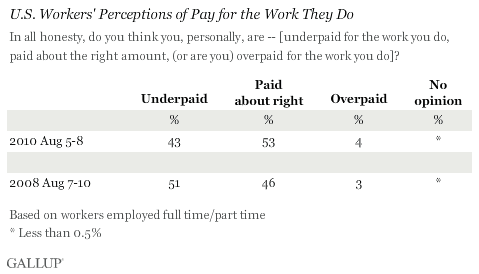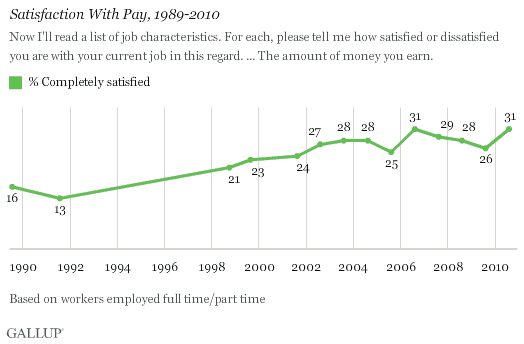PRINCETON, NJ -- Fewer than half of U.S. workers today, 43%, believe they are underpaid for the work they do, down from 51% in 2008. The slight majority, 53%, now say they are paid the right amount.

These results, from Gallup's Aug. 5-8 Work and Education poll, are based on interviews with adults aged 18 and older who are currently employed either full time or part time.
U.S. workers' heightened appreciation for their pay likely reflects today's challenging job market. National unemployment has registered roughly 9.5% in recent months, significantly higher than the 6.1% jobless rate at the time of Gallup's prior measure in August 2008. Gallup also finds roughly a quarter of workers worried that they could soon lose their job or see a pay reduction -- nearly twice the August 2008 level.
Separately, Gallup finds 31% of workers saying they are "completely satisfied" with the amount of money they earn. That matches the record-high level of satisfaction with pay Gallup recorded in 2006, and is slightly higher than the average 28% satisfaction seen on this measure over the past decade.

When those who are "somewhat satisfied" are factored in, a combined 74% of workers today are generally satisfied with what they earn, while 26% are dissatisfied.
Bottom Line
Shock waves from the global financial crisis that started with the fall of Lehman Brothers in September 2008 are still reverberating through public attitudes. Today's workers continue to express heightened concern about being laid off or having their pay or benefits cut back, and only 10% say it's a good time to find a quality job (compared with 20% before the crisis). These findings help explain why workers may now be happier to hang on to the jobs they have than they were only two years ago, without looking for greater financial rewards.
Results for this Gallup poll are based on telephone interviews conducted Aug. 5-8, 2010, with a random sample of 1,013 adults, aged 18 and older, living in the continental U.S., selected using random-digit-dial sampling.
For results based on the total sample of national adults, one can say with 95% confidence that the maximum margin of sampling error is ±4 percentage points.
For results based on the total sample of 499 adults employed full or part time, one can say with 95% confidence that the maximum margin of sampling error is ±5 percentage points.
Interviews are conducted with respondents on landline telephones (for respondents with a landline telephone) and cellular phones (for respondents who are cell phone-only). Each sample includes a minimum quota of 150 cell phone-only respondents and 850 landline respondents, with additional minimum quotas among landline respondents for gender within region. Landline respondents are chosen at random within each household on the basis of which member had the most recent birthday.
Samples are weighted by gender, age, race, education, region, and phone lines. Demographic weighting targets are based on the March 2009 Current Population Survey figures for the aged 18 and older non-institutionalized population living in continental U.S. telephone households. All reported margins of sampling error include the computed design effects for weighting and sample design.
In addition to sampling error, question wording and practical difficulties in conducting surveys can introduce error or bias into the findings of public opinion polls.
View methodology, full question results, and trend data.
For more details on Gallup's polling methodology, visit www.gallup.com.
